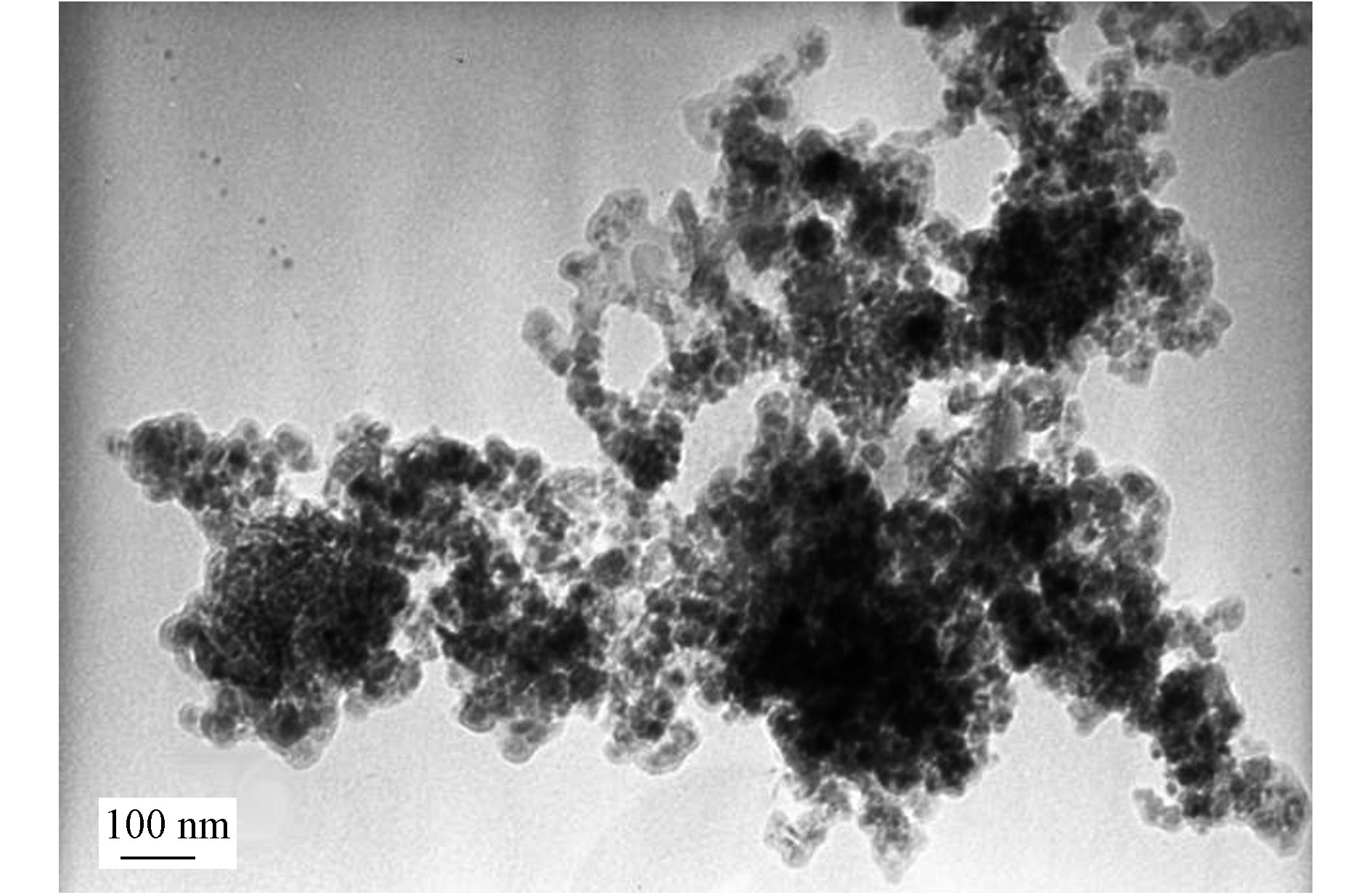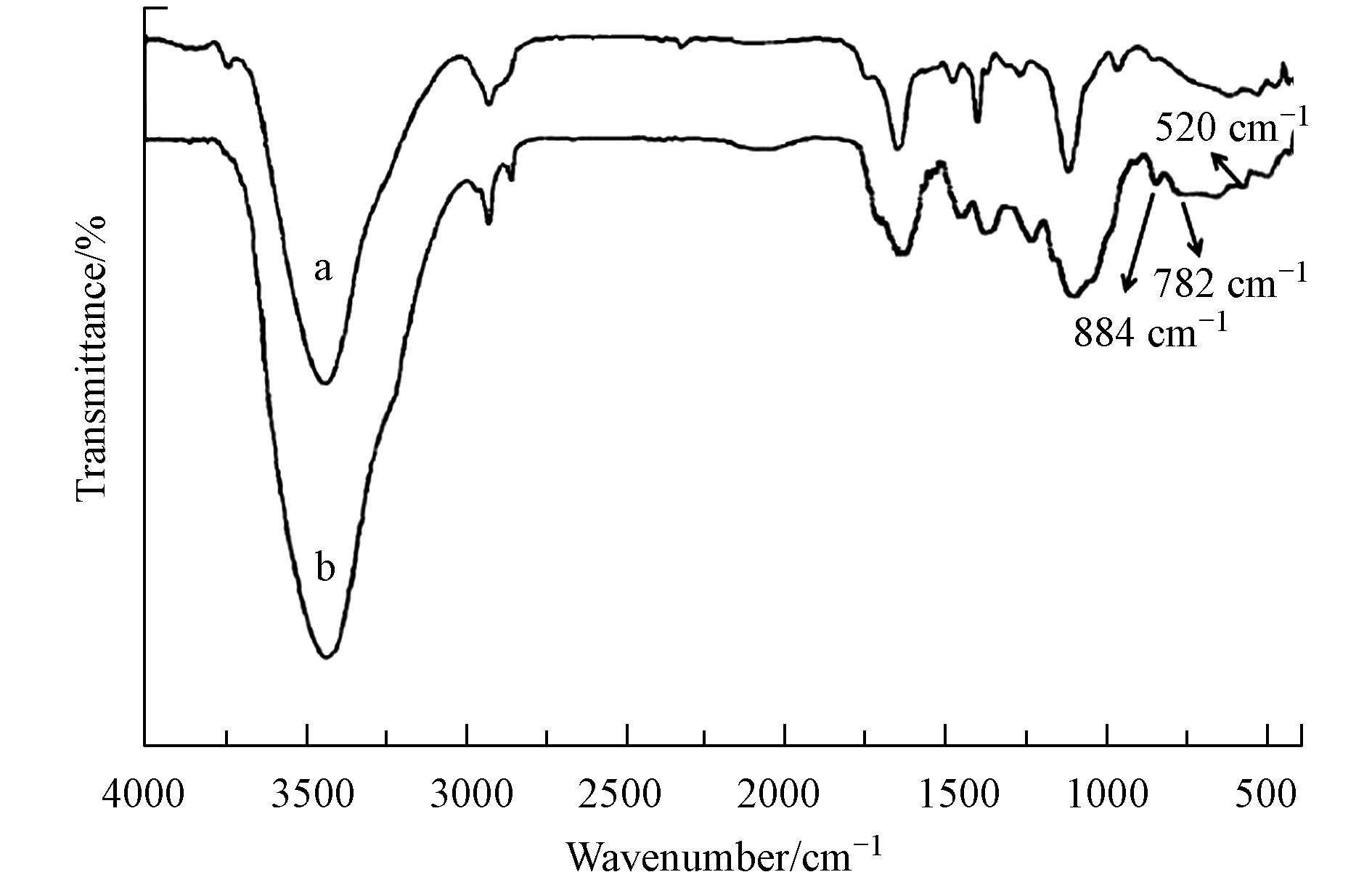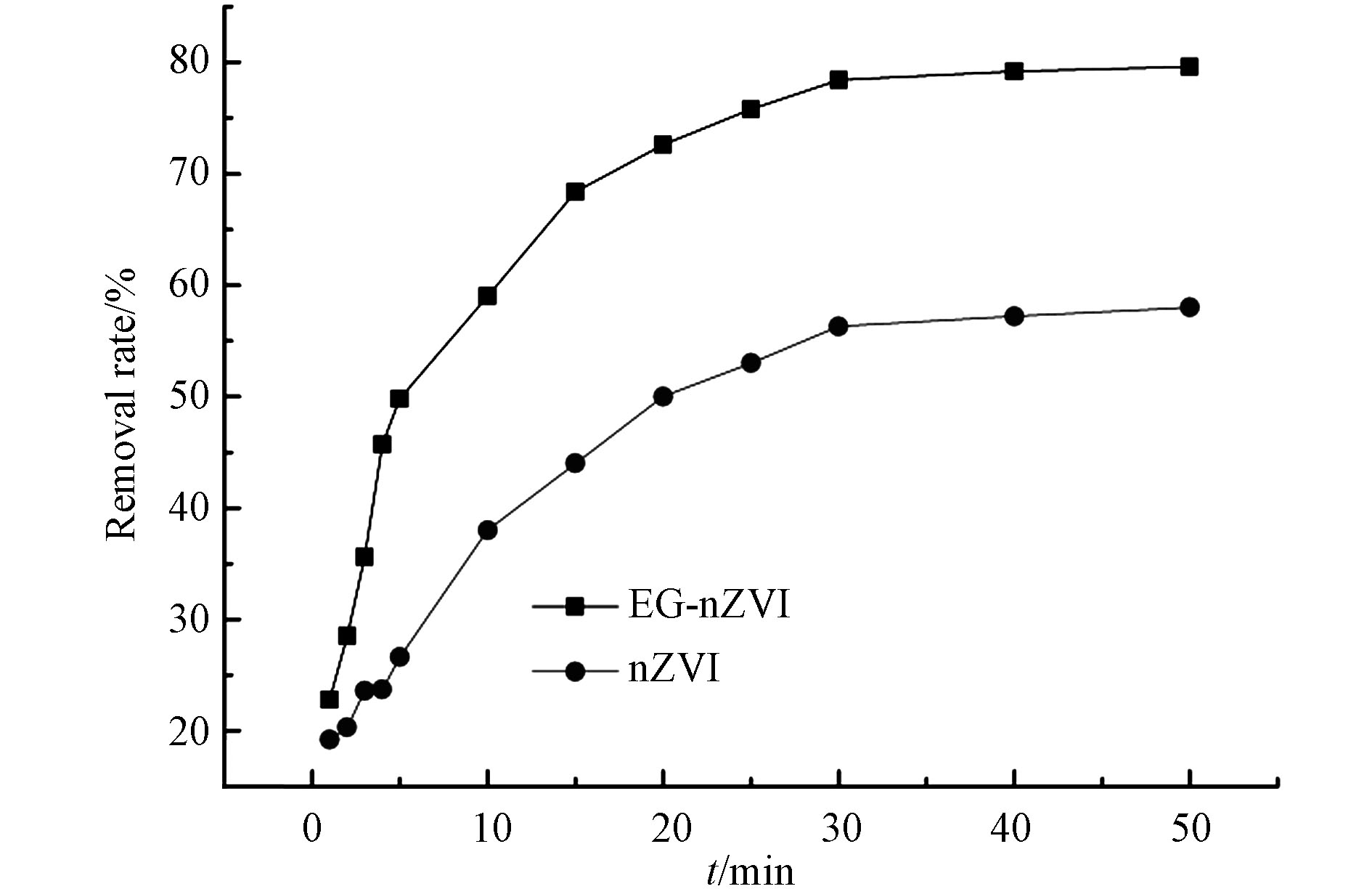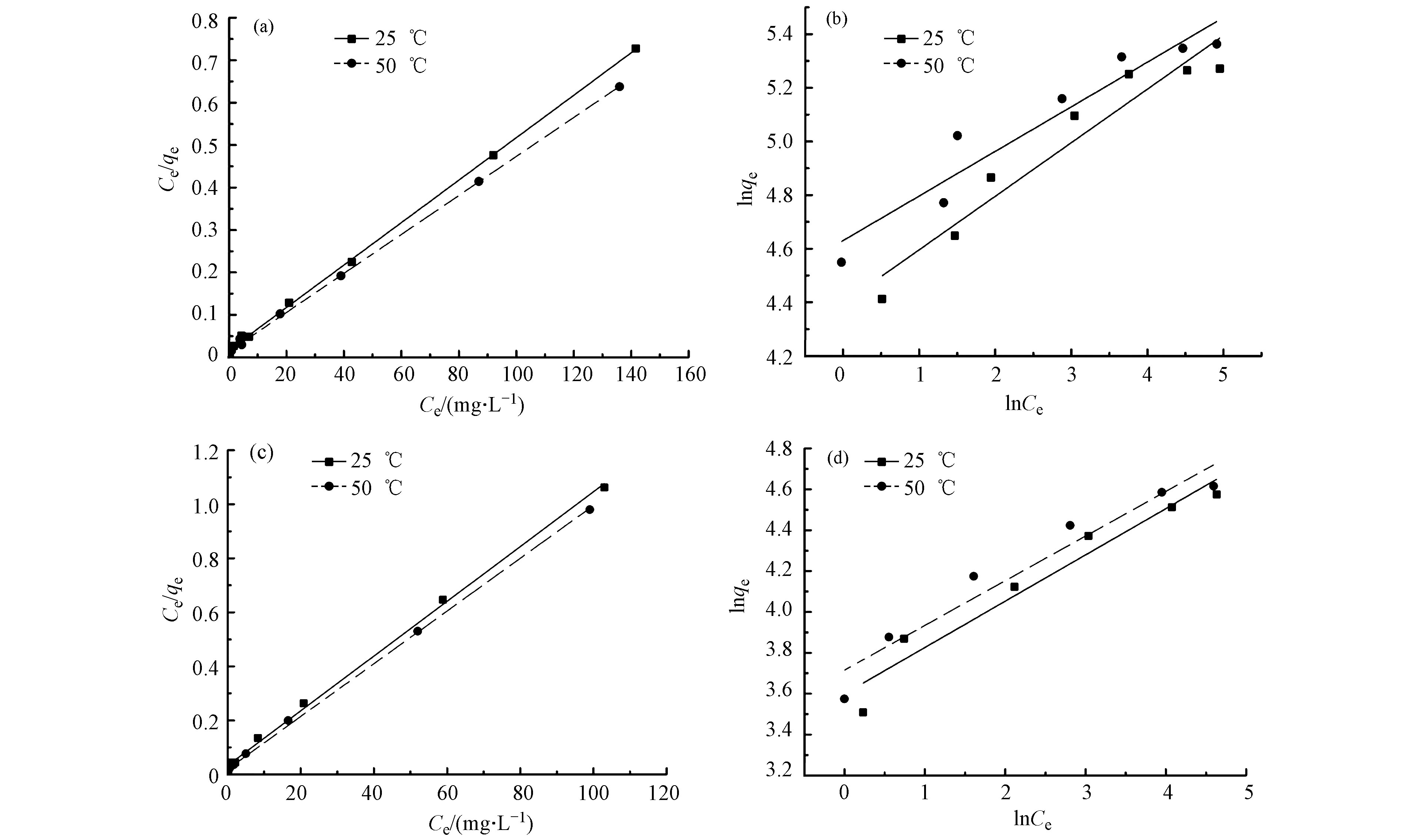-
随着工业的发展,大量重金属被排入土壤和水体,危害生态环境[1-2]。镉在天然水中含量很低,水体污染的镉主要来源是含镉工业如电镀、塑料加工、采矿业和液晶屏制造等产生的废水[3-4]。长期的工业化过程促使排放的镉不断积累,导致水体中镉污染日益严重。用镉污染的水,来进行灌溉,会造成粮食产区镉土壤污染问题,致使粮食中镉超标,并通过食物链积累威胁人类健康[5]。镉是有毒重金属,可致癌,能够在人体的肝、肾和骨等脏器和组织中富集,会导致多种病症的发生如贫血、高血压、神经痛、肾炎和分泌物紊乱等[6]。
纳米零价铁(nanoscale Zero-Valent Iron,简称nZVI)作为新型去除水体中重金属的材料具有高表面活性、强还原性和环境相容性,其修复技术已成为环境领域中极具潜力的新方向[7-9]。传统制备纳米零价铁的方法,即采用硼氢化物(如硼氢化钠)与二价或三价的铁盐(如FeSO4或FeCl3)反应生成纳米零价铁,由于硼氢化物为有毒物质,反应过程易燃易爆,并需氮气保护,制备成本高,限制纳米零价铁有效的应用于环境修复工程中。近年来,一种新型绿色合成纳米零价铁的方法即利用植物提取液与铁盐制备nZVI受到更多学者的青睐,该方法不含硼氢化物等危险物质,有利于植物资源化利用,同时反应成本低廉,其原理是利用植物提取液的有效成分如多酚类物质还原铁盐制备nZVI[10-12]。
纳米零价铁反应活性虽强,但稳定性较差,在空气中放置一段时间反应性明显降低[13],为了提高其稳定性和吸附效率,本研究拟构建石墨基纳米零价铁。石墨基材中膨胀石墨(expanded graphite,简称EG)具有多层次、丰富的孔结构和巨大的孔隙体积和比表面积,对重金属具有优良的吸附性能[14-16]。制备纳米零价铁与膨胀石墨相结合的复合吸附剂,更有利于对水中镉的去除。
本文以黑茶提取液和硫酸亚铁绿色合成nZVI,在制备反应体系中,同时填加EG,合成膨胀石墨负载纳米零价铁(EG-nZVI)。对二者进行表征,并研究nZVI和EG-nZVI对水溶液中Cd(Ⅱ)的去除,通过考察各种因素对去除效果的影响,为构建石墨基负载零价铁的吸附剂对水中重金属的去除提供支持。
-
可膨胀石墨(膨胀倍率150 mL·g−1,青岛南墅宏达石墨制品有限公司),黑茶(湖南华莱生物科技有限公司),盐酸,FeSO4·7H2O,硝酸镉,氢氧化钠,无水乙醇(分析纯,国药集团化学试剂有限公司).
电子恒速搅拌器(D2010W,上海梅颖浦仪器仪表制造有限公司),箱式电阻炉(SX2-4-10,上海实验仪器厂),超纯水机(EPED-S2-90DF,上海技舟化工科技有限公司),恒温振荡器(SHZ-C,上海精密仪器仪表有限公司),真空干燥箱(DZF-6096,上海一恒科学仪器有限公司),水循环式多用真空泵(SHB-Ⅲ,郑州杜甫仪器厂),TDL-40B离心机(TDL-40B,上海安亭科学仪器厂),原子吸收光谱(SP-3520AA,上海光谱仪器),超声波反应器(KH-300DE,昆山禾创超声仪器有限公司),场发射电子显微镜(S4800,日本理学),透射电子显微镜(Tecnai G2 F20S-TWIN,美国FEI公司),比表面积测定仪(ASAP2460,美国麦克仪器),傅里叶转换红外光谱仪(Vertex 70v,德国布鲁克公司),X光衍射仪(D/max2200PC,日本理学株式会社).
-
将5 g的可膨胀石墨放置于坩埚中,在700 ℃马弗炉中加热60 s后,得到膨胀石墨备用。
-
称取60 g的黑茶,放入 1 L超纯水中,80 ℃水浴1 h,过滤,得到黑茶提取液备用。将100 mL黑茶提取液与0.1 mol·L−1 FeSO4溶液按照体积比2∶1慢慢混合,期间不断搅拌,反应约0.5 h,生成棕黑色的浑浊溶液。将棕黑色浑浊溶液于5000 r·min−1离心10 min,沉淀用超纯水和无水乙醇清洗两遍,置于真空干燥箱70 ℃干燥24 h以上,得到nZVI粉末[17]。
黑茶提取液制备同上,称取0.5 g EG加入到100 mL黑茶提取液中,充分混合,将0.5倍体积的0.1 mol·L−1 FeSO4溶液慢慢加入到混有EG的黑茶提取液中,期间不断搅拌,反应约0.5 h,溶液颜色至棕黑色,将富含EG的浑浊溶液分批用0.45 μm醋酸纤维滤膜真空抽滤,将滤膜上的EG复合材料置于真空干燥箱70 ℃干燥24 h,得到EG-nZVI。
-
配制100 mg·L−1的Cd(Ⅱ)溶液。分别称取一定量EG-nZVI和nZVI置于50 mLCd(Ⅱ)溶液中,在超声波辅助下,设定不同时间、pH、投加量和Cd(Ⅱ)浓度,反应结束后,采用火焰原子吸收分光光度计测定反应前后溶液中Cd的浓度,复合材料对污染物Cd(Ⅱ)的去除效果评价,如公式(1)所示:
式中,C0、Ct分别为初始时刻与处理后t时刻的Cd浓度,mg·L−1。
-
在不同Cd(Ⅱ)初始浓度下,分别取50 mL置于两个锥形瓶中,分别加入一定量的nZVI和EG-nZVI,在25 ℃和50 ℃于超声波辅助下达到吸附平衡,用原子吸收光谱法进行Cd(Ⅱ)浓度的测定,并计算其吸附量。绘制两个温度下的吸附等温线并拟合。
-
取一定量nZVI和EG-nZVI分别与100 mLCd(Ⅱ)溶液混合,常温常压在超声波辅助条件下初始5 min每隔1 min测定溶液的Cd(Ⅱ)浓度,之后每隔5 min测定溶液的Cd(Ⅱ)浓度,绘制吸附动力学曲线并拟合。
-
EG图片见图1(a),片层之间有许多蜂窝状或网状多边形的微细孔隙;EG-nZVI图片见图1(b),从图中可以看出EG表面分散了细小的颗粒状物质,尺寸大小为纳米级,表明有纳米铁颗粒散布在膨胀石墨的孔隙层的表面;nZVI图片见图1(c),从图中看出nZVI的形状是直径约为40—50 nm的球状,分散性较好。
通过能谱仪检测两种样品中的元素组成见图2。图2(a)显示了nZVI的主要元素组成为C(45.08%)、O(35.82%)、S(1.95%)、K(0.96%)、Si(0.71%)和Fe(11.64%),说明了新材料中含有纳米铁。图2(b)显示了EG-nZVI的主要元素组成为C(75.93%)、O(15.3%)、S(1.35%)、K(0.74%)、Si(0.88%)和Fe(6.7%),说明了膨胀石墨上确实负载了纳米铁,由于膨胀石墨作为载体,使得元素组成中C的含量大幅度增加。
-
将合成的nZVI的形貌和粒径通过透射电镜来观察,其TEM图片如图3所示。由图3可以看出,所制备的纳米铁颗粒是近似球形的颗粒,分散性较好,纳米铁颗粒的粒径约为40—50 nm,同FESEM得出结果一致。另外,还可以看出,绿色合成纳米铁具有核壳结构,与传统方法合成的nZVI的形貌结构相近,其核心是零价铁,外壳可能是茶叶提取液中的有机物和铁的氧化物。
-
EG的FTIR见图4。从图4a看出,EG在3444 cm−1处的吸收峰是O—H伸缩振动峰。在2927 cm−1和2855 cm−1处的峰对应于饱和烃C—H(—CH2、—CH3以及—CH=O)的伸缩振动;1150 cm−1处的吸收峰是C—O或C—O—C的伸缩振动峰;1370 cm−1处的吸收峰是C—C的伸缩振动峰,分析可知EG表面可能有羟基、醚基等官能团存在。由图4b看出,负载了零价铁后,EG-nZVI在884 cm−1和782 cm−1位置出现α-FeOOH的特征吸收峰,以及520 cm−1处的Fe2O3特征吸收峰。对比负载前EG的光谱图可知负载后EG上确有铁系物生成。
-
图5为不同样品的XRD图。从图5a可以看出,nZVI图谱中在2θ=44.8°附近有α-Fe体心立方结构晶面(110)的特征衍射宽峰[18],峰型不是很明显,可能是由于nZVI表面被有机物质包覆。2θ=23°—24°左右出现了1个宽驼峰,为作为封盖剂的黑茶提取物中的有机物质(茶多酚,维生素等)[19-20]。从图5b可以看出,EG在2θ为26.08°和54.6°附近具有石墨晶体(002)和(004)的特征衍生峰[21]。从图5c可以看出,负载了零价铁的膨胀石墨,EG-nZVI在2θ为26.08°和54.6°附近仍然存在EG衍射峰,且峰型尖锐,表明EG经负载后晶体依然完整;在2θ=44.92°处也有α-Fe 体心立方结构晶面(110)的特征峰,表明铁系物以晶体形式负载在EG表面,成型较好。
-
比表面积测定结果显示见表1,由于高比表面积的零价铁的均匀负载,使得EG-nZVI的比表面积为145.9 m2·g−1,略高于EG的137.5 m2·g−1。由于二者均有较高的孔体积,具备吸附重金属的结构基础。
-
图6为不同反应时间EG-nZVI和nZVI对Cd(Ⅱ)去除的效果。由图6可以看出,二者对水中Cd(II)的去除率先逐渐增加,然后趋缓,在30 min时达到吸附平衡。EG-nZVI对水中Cd(Ⅱ)的去除率明显高于nZVI。经过膨胀石墨负载以后的纳米零价铁,可有效防止纳米零价铁的氧化和团聚,并提高它的比表面积和化学稳定性,增加了纳米零价铁对Cd(Ⅱ)的吸附作用。
-
图7为不同投加量EG-nZVI和nZVI对Cd(Ⅱ)的去除效果。由图7可见,随着nZVI和EG-nZVI投加量的递增,Cd(Ⅱ)的去除率随之升高。当nZVI和EG-nZVI的投加量分别达到0.4 g·L−1和2 g·L−1时,继续增加投加量去除率基本不变,EG-nZVI的最大去除率(78.2%)明显高于nZVI(56.1%)。随着nZVI和EG-nZVI量的增加,其有效比表面积也相对应增加,所以吸附作用效果明显,去除率有效提高。但当投加量达到一定程度,吸附质与吸附剂饱和,若继续加入吸附剂,可能会导致零价铁发生团聚或者膨胀石墨间的混聚,导致吸附效果变差。
-
图8为pH对EG-nZVI和nZVI去除Cd(Ⅱ)的影响。溶液pH较低时,Cd(Ⅱ)的去除效果较差,原因如下:(1)溶液中的H+浓度大,吸附剂表面会带正电,与溶液中的Cd(Ⅱ)排斥,吸附作用减弱。(2)溶液的H+浓度增大,H+可能会与溶液中的Cd(Ⅱ)竞争吸附剂表面的吸附点位。当pH逐渐从中性过度到碱性时,上述影响因素均减弱,Cd(Ⅱ)的去除效果明显提高。继续增大pH至8以上时,部分Cd(Ⅱ)生成Cd(OH)2沉淀,使得Cd(Ⅱ)的去除率依然小幅增加。考虑到溶液碱性过大,会导致二次污染,增加修复难度,同时碱性的增加使得Cd(Ⅱ)的去除效果增加并不明显,综合处理效果和经济成本因素考虑定为pH8较为合适。
-
图9为Cd(Ⅱ)初始浓度对EG-nZVI和nZVI去除效果的影响。从图9可知,随着Cd(Ⅱ)初始浓度的增加,二者对Cd(Ⅱ)去除率逐渐降低。说明当投加的吸附剂量一定时,可提供的吸附位点是具有饱和性的,能够吸附溶液中吸附质的量是基本固定的,如果继续增大吸附质(Cd(Ⅱ))的量,由于吸附位点的相对不足,因此去除率逐渐降低。
-
纳米零价铁反应活性高,易被空气氧化而失去反应活性(如还原效应,吸附效应)。为了测定EG-nZVI和nZVI的稳定性,将新制备的EG-nZVI和nZVI放置于常温常压下,每隔一段时间测试其对溶液中Cd(Ⅱ)的去除效果。图10为EG-nZVI和nZVI的放置天数对Cd(Ⅱ)去除率的影响,结果显示随着放置时间的增加,二者对Cd(Ⅱ)去除的反应活性均下降,说明纳米零价铁被空气中氧气氧化,反应活性降低。放置15 d后EG-nZVI对Cd(Ⅱ)的去除效能损失约34%,而nZVI对Cd(Ⅱ)的去除效能损失约82%,说明EG的负载,其介孔结构在一定程度上有助于保护nZVI的反应活性,降低氧气对nZVI的氧化作用。
-
采用Langmuir和Freundlich吸附等温方程进行实验数据分析。Langmuir方程主要用于描述单层吸附,而Freundlich方程主要用来描述多层吸附。根据固-液吸附经验公式,通过Langmuir和Freundlich等温吸附模型,对nZVI吸附含镉废水的吸附结果进行线性拟合,结果如图11所示。Langmuir和Freundlich等温吸附模型相关参数和修正系数如表2所示。
从图11和表2可以发现,无论对于EG-nZVI还是nZVI,对于Cd(Ⅱ)的去除,Langmuir模型较之Freundich模型的拟合效果要好,Langmuir吸附模型的相关系数(R2)较高,均为0.99以上,说明吸附是单层吸附,EG-nZVI和nZVI对Cd(Ⅱ)反应过程可能为化学吸附。Freundich模型系数1/n处于0.1—0.5范围内,说明吸附过程容易进行。
-
为描述EG-nZVI和nZVI对Cd(Ⅱ)的去除机理和动力学行为,利用伪一级动力学方程(式2)和伪二级动力学方程(式3) 对数据进行拟合,结果如图12所示,拟合参数分别见表3。
式中,qeq为平衡吸附量(mg·g−1);qt为任意时刻t的吸附量(mg·g−1);K1为伪一级方程吸附速率常数(min−1)。
式中,qeq为平衡吸附量(mg·g−1);qt为任意时刻t的吸附量(mg·g−1);K2为伪二级速率常数(g·(mol·min)−1).
表3的拟合曲线均与伪二级动力学方程具有高的契合度。nZVI和EG-nZVI对Cd(Ⅱ)的伪二级动力学方程的回归系数分别是0.9692和0.9956,明显高于伪一级动力学方程0.9135和0.8996,伪二级动力学方程计算得出的理论平衡吸附量(qeq)与实验测得的平衡吸附量(qexp) 最符合。由此说明nZVI和EG-nZVI对Cd(Ⅱ)的去除更符合准二级速率模型,说明化学吸附是限速步骤。
化学吸附的成因如下:由于Fe2+/Fe标准电极电位为−0.44,而Cd2+/Cd标准电极电位为−0.40,致使nZVI内核Fe原子难以起到还原作用,nZVI与Cd(Ⅱ)之间的反应更多是nZVI表面钝化层FeOOH与Cd(Ⅱ)之间的表面电荷吸附或化学络合吸附[22]。
-
(1)采用绿色合成法制备两种新型吸附剂EG-nZVI和nZVI。经FESEM和TEM表征nZVI为直径40—50 nm的球状,分散性较好,经EG负载后,纳米零价铁散布在膨胀石墨的孔隙层的表面。FTIR,EDS和XRD检测二者样品中均有铁元素的存在。BET测定显示EG-nZVI有较高的比表面积和孔体积。
(2)EG-nZVI和nZVI对含有100 mg·L −1 Cd(Ⅱ)水溶液处理的单因素优化工艺为:添加EG-nZVI 2.0 g·L −1或nZVI 0.4 g·L −1,常温下,pH 8,在超声波辅助下反应30 min,Cd(Ⅱ)去除率分别为78.4%和56.3%。在最适条件下,EG-nZVI对Cd(Ⅱ)的去除效果优于nZVI。
(3)在空气中放置不同的天数进行测定,结果显示随着放置时间的增加,EG-nZVI和nZVI对Cd(Ⅱ)去除的反应活性均下降,说明纳米零价铁在空气中被氧化,反应活性降低。放置15 d后EG-nZVI对Cd(Ⅱ)的去除效能损失(约34%)远小于nZVI对Cd(Ⅱ)的去除效能损失(约82%),说明负载EG后,对零价铁反应活性起到一定的保护作用。
(4)EG-nZVI和nZVI对Cd(Ⅱ)的去除过程拟合更符合伪二级动力学模型和Langmuir吸附等温模型。
绿色合成膨胀石墨负载纳米零价铁去除水中Cd(Ⅱ)
Research on removal of cadmium(Ⅱ) by green synthesized nanoscale zero-valent iron supported on expanded graphite
-
摘要: 工业生产中Cd(Ⅱ)对水体的危害,本文合成了两种新型吸附剂,纳米零价铁(nZVI)和膨胀石墨负载纳米零价铁(EG-nZVI)。利用 FESEM、EDS、TEM、XRD、FTIR及BET比表面积测定对nZVI和EG-nZVI进行表征,探讨了二者对溶液中Cd(Ⅱ)的去除效果。结果表明,含有100 mg·L −1Cd(Ⅱ)溶液,nZVI和EG-nZVI的投加量分别达到0.4 mg·L −1和2 mg·L −1,在超声波辅助的条件下,常温、pH 8、反应30 min时,Cd(Ⅱ)去除率分别为56.3%和78.4%。EG-nZVI和nZVI去除Cd (II)过程均符合伪二级动力学模型和Langmuir吸附等温模型;将吸附剂置于空气中不同时间,测定结果显示EG-nZVI对Cd (Ⅱ)的去除活性明显高于nZVI,说明EG-nZVI较nZVI有更高的去除效能和稳定性。Abstract: In order to protect the water from the pollution of Cd(Ⅱ) from industrial production process,two new adsorbents, nano zero valent iron (nZVI) and nanoscale zero valent iron supported on expanded graphite (EG-nZVI) were green synthesized. EG-nZVI and nZVI were characterized by FESEM、TEM、EDS、XRD、FTIR and BET specific surface area measurement. In addition, EG-nZVI and nZVI were investigated on the removal of Cd(Ⅱ) of aqueous solution. Results indicated that, for 100 mg·L−1 Cd(Ⅱ) solution, adding 0.4 mg·L−1 nZVI and 2 mg·L−1 EG-nZVI respectively, removal rate of Cd(Ⅱ) was 56.3% and 78.4% which was achieved under the following conditions: at normal atmospheric temperature, pH 8, for 30 min and ultrasound assisted. The removal processes of both were well fitted pseudo second-order dynamic model and Langmuir adsorption isotherm model. EG-nZVI showed high potential to remove Cd(Ⅱ) in aqueous solution than nZVI due to its high removal capability and stability after being placed in the air for different time.
-
Key words:
- expanded graphite /
- nanoscale zero-valent iron /
- cadmium(Ⅱ) /
- green synthesis /
- adsorption
-
随着工业的发展,大量重金属被排入土壤和水体,危害生态环境[1-2]。镉在天然水中含量很低,水体污染的镉主要来源是含镉工业如电镀、塑料加工、采矿业和液晶屏制造等产生的废水[3-4]。长期的工业化过程促使排放的镉不断积累,导致水体中镉污染日益严重。用镉污染的水,来进行灌溉,会造成粮食产区镉土壤污染问题,致使粮食中镉超标,并通过食物链积累威胁人类健康[5]。镉是有毒重金属,可致癌,能够在人体的肝、肾和骨等脏器和组织中富集,会导致多种病症的发生如贫血、高血压、神经痛、肾炎和分泌物紊乱等[6]。
纳米零价铁(nanoscale Zero-Valent Iron,简称nZVI)作为新型去除水体中重金属的材料具有高表面活性、强还原性和环境相容性,其修复技术已成为环境领域中极具潜力的新方向[7-9]。传统制备纳米零价铁的方法,即采用硼氢化物(如硼氢化钠)与二价或三价的铁盐(如FeSO4或FeCl3)反应生成纳米零价铁,由于硼氢化物为有毒物质,反应过程易燃易爆,并需氮气保护,制备成本高,限制纳米零价铁有效的应用于环境修复工程中。近年来,一种新型绿色合成纳米零价铁的方法即利用植物提取液与铁盐制备nZVI受到更多学者的青睐,该方法不含硼氢化物等危险物质,有利于植物资源化利用,同时反应成本低廉,其原理是利用植物提取液的有效成分如多酚类物质还原铁盐制备nZVI[10-12]。
纳米零价铁反应活性虽强,但稳定性较差,在空气中放置一段时间反应性明显降低[13],为了提高其稳定性和吸附效率,本研究拟构建石墨基纳米零价铁。石墨基材中膨胀石墨(expanded graphite,简称EG)具有多层次、丰富的孔结构和巨大的孔隙体积和比表面积,对重金属具有优良的吸附性能[14-16]。制备纳米零价铁与膨胀石墨相结合的复合吸附剂,更有利于对水中镉的去除。
本文以黑茶提取液和硫酸亚铁绿色合成nZVI,在制备反应体系中,同时填加EG,合成膨胀石墨负载纳米零价铁(EG-nZVI)。对二者进行表征,并研究nZVI和EG-nZVI对水溶液中Cd(Ⅱ)的去除,通过考察各种因素对去除效果的影响,为构建石墨基负载零价铁的吸附剂对水中重金属的去除提供支持。
1. 实验部分(Experimental section)
1.1 材料与仪器
可膨胀石墨(膨胀倍率150 mL·g−1,青岛南墅宏达石墨制品有限公司),黑茶(湖南华莱生物科技有限公司),盐酸,FeSO4·7H2O,硝酸镉,氢氧化钠,无水乙醇(分析纯,国药集团化学试剂有限公司).
电子恒速搅拌器(D2010W,上海梅颖浦仪器仪表制造有限公司),箱式电阻炉(SX2-4-10,上海实验仪器厂),超纯水机(EPED-S2-90DF,上海技舟化工科技有限公司),恒温振荡器(SHZ-C,上海精密仪器仪表有限公司),真空干燥箱(DZF-6096,上海一恒科学仪器有限公司),水循环式多用真空泵(SHB-Ⅲ,郑州杜甫仪器厂),TDL-40B离心机(TDL-40B,上海安亭科学仪器厂),原子吸收光谱(SP-3520AA,上海光谱仪器),超声波反应器(KH-300DE,昆山禾创超声仪器有限公司),场发射电子显微镜(S4800,日本理学),透射电子显微镜(Tecnai G2 F20S-TWIN,美国FEI公司),比表面积测定仪(ASAP2460,美国麦克仪器),傅里叶转换红外光谱仪(Vertex 70v,德国布鲁克公司),X光衍射仪(D/max2200PC,日本理学株式会社).
1.2 试验方法
1.2.1 EG的制备
将5 g的可膨胀石墨放置于坩埚中,在700 ℃马弗炉中加热60 s后,得到膨胀石墨备用。
1.2.2 nZVI和EG-nZVI的制备
称取60 g的黑茶,放入 1 L超纯水中,80 ℃水浴1 h,过滤,得到黑茶提取液备用。将100 mL黑茶提取液与0.1 mol·L−1 FeSO4溶液按照体积比2∶1慢慢混合,期间不断搅拌,反应约0.5 h,生成棕黑色的浑浊溶液。将棕黑色浑浊溶液于5000 r·min−1离心10 min,沉淀用超纯水和无水乙醇清洗两遍,置于真空干燥箱70 ℃干燥24 h以上,得到nZVI粉末[17]。
黑茶提取液制备同上,称取0.5 g EG加入到100 mL黑茶提取液中,充分混合,将0.5倍体积的0.1 mol·L−1 FeSO4溶液慢慢加入到混有EG的黑茶提取液中,期间不断搅拌,反应约0.5 h,溶液颜色至棕黑色,将富含EG的浑浊溶液分批用0.45 μm醋酸纤维滤膜真空抽滤,将滤膜上的EG复合材料置于真空干燥箱70 ℃干燥24 h,得到EG-nZVI。
1.2.3 EG-nZVI和nZVI对水中Cd(Ⅱ)的去除
配制100 mg·L−1的Cd(Ⅱ)溶液。分别称取一定量EG-nZVI和nZVI置于50 mLCd(Ⅱ)溶液中,在超声波辅助下,设定不同时间、pH、投加量和Cd(Ⅱ)浓度,反应结束后,采用火焰原子吸收分光光度计测定反应前后溶液中Cd的浓度,复合材料对污染物Cd(Ⅱ)的去除效果评价,如公式(1)所示:
R=C0−CtC0×100% (1) 式中,C0、Ct分别为初始时刻与处理后t时刻的Cd浓度,mg·L−1。
1.2.4 nZVI和EG-nZVI去除Cd(Ⅱ)的吸附等温线
在不同Cd(Ⅱ)初始浓度下,分别取50 mL置于两个锥形瓶中,分别加入一定量的nZVI和EG-nZVI,在25 ℃和50 ℃于超声波辅助下达到吸附平衡,用原子吸收光谱法进行Cd(Ⅱ)浓度的测定,并计算其吸附量。绘制两个温度下的吸附等温线并拟合。
1.2.5 EG-nZVI和Cd(Ⅱ)吸附动力学
取一定量nZVI和EG-nZVI分别与100 mLCd(Ⅱ)溶液混合,常温常压在超声波辅助条件下初始5 min每隔1 min测定溶液的Cd(Ⅱ)浓度,之后每隔5 min测定溶液的Cd(Ⅱ)浓度,绘制吸附动力学曲线并拟合。
2. 结果与讨论 (Results and discussion)
2.1 复合材料的表征
2.1.1 FESEM和EDS分析
EG图片见图1(a),片层之间有许多蜂窝状或网状多边形的微细孔隙;EG-nZVI图片见图1(b),从图中可以看出EG表面分散了细小的颗粒状物质,尺寸大小为纳米级,表明有纳米铁颗粒散布在膨胀石墨的孔隙层的表面;nZVI图片见图1(c),从图中看出nZVI的形状是直径约为40—50 nm的球状,分散性较好。
通过能谱仪检测两种样品中的元素组成见图2。图2(a)显示了nZVI的主要元素组成为C(45.08%)、O(35.82%)、S(1.95%)、K(0.96%)、Si(0.71%)和Fe(11.64%),说明了新材料中含有纳米铁。图2(b)显示了EG-nZVI的主要元素组成为C(75.93%)、O(15.3%)、S(1.35%)、K(0.74%)、Si(0.88%)和Fe(6.7%),说明了膨胀石墨上确实负载了纳米铁,由于膨胀石墨作为载体,使得元素组成中C的含量大幅度增加。
2.1.2 TEM分析
将合成的nZVI的形貌和粒径通过透射电镜来观察,其TEM图片如图3所示。由图3可以看出,所制备的纳米铁颗粒是近似球形的颗粒,分散性较好,纳米铁颗粒的粒径约为40—50 nm,同FESEM得出结果一致。另外,还可以看出,绿色合成纳米铁具有核壳结构,与传统方法合成的nZVI的形貌结构相近,其核心是零价铁,外壳可能是茶叶提取液中的有机物和铁的氧化物。
2.1.3 FTIR分析
EG的FTIR见图4。从图4a看出,EG在3444 cm−1处的吸收峰是O—H伸缩振动峰。在2927 cm−1和2855 cm−1处的峰对应于饱和烃C—H(—CH2、—CH3以及—CH=O)的伸缩振动;1150 cm−1处的吸收峰是C—O或C—O—C的伸缩振动峰;1370 cm−1处的吸收峰是C—C的伸缩振动峰,分析可知EG表面可能有羟基、醚基等官能团存在。由图4b看出,负载了零价铁后,EG-nZVI在884 cm−1和782 cm−1位置出现α-FeOOH的特征吸收峰,以及520 cm−1处的Fe2O3特征吸收峰。对比负载前EG的光谱图可知负载后EG上确有铁系物生成。
2.1.4 XRD分析
图5为不同样品的XRD图。从图5a可以看出,nZVI图谱中在2θ=44.8°附近有α-Fe体心立方结构晶面(110)的特征衍射宽峰[18],峰型不是很明显,可能是由于nZVI表面被有机物质包覆。2θ=23°—24°左右出现了1个宽驼峰,为作为封盖剂的黑茶提取物中的有机物质(茶多酚,维生素等)[19-20]。从图5b可以看出,EG在2θ为26.08°和54.6°附近具有石墨晶体(002)和(004)的特征衍生峰[21]。从图5c可以看出,负载了零价铁的膨胀石墨,EG-nZVI在2θ为26.08°和54.6°附近仍然存在EG衍射峰,且峰型尖锐,表明EG经负载后晶体依然完整;在2θ=44.92°处也有α-Fe 体心立方结构晶面(110)的特征峰,表明铁系物以晶体形式负载在EG表面,成型较好。
2.1.5 BET比表面积的测定
比表面积测定结果显示见表1,由于高比表面积的零价铁的均匀负载,使得EG-nZVI的比表面积为145.9 m2·g−1,略高于EG的137.5 m2·g−1。由于二者均有较高的孔体积,具备吸附重金属的结构基础。
表 1 不同样品的比表面积Table 1. Specific surface area of different specimens样品 Specimen 比表面积/(m2 ·g−1) Specific surface area 吸附累计孔体积/(cm3 ·g−1) Adsorption cumulative pore volume EG 137.5 0.227 EG-nZVI 145.9 0.221 2.2 EG-nZVI和nZVI对水溶液中Cd(Ⅱ)的去除效果
2.2.1 反应时间对去除率的影响
图6为不同反应时间EG-nZVI和nZVI对Cd(Ⅱ)去除的效果。由图6可以看出,二者对水中Cd(II)的去除率先逐渐增加,然后趋缓,在30 min时达到吸附平衡。EG-nZVI对水中Cd(Ⅱ)的去除率明显高于nZVI。经过膨胀石墨负载以后的纳米零价铁,可有效防止纳米零价铁的氧化和团聚,并提高它的比表面积和化学稳定性,增加了纳米零价铁对Cd(Ⅱ)的吸附作用。
2.2.2 EG-nZVI投加量对去除率的影响
图7为不同投加量EG-nZVI和nZVI对Cd(Ⅱ)的去除效果。由图7可见,随着nZVI和EG-nZVI投加量的递增,Cd(Ⅱ)的去除率随之升高。当nZVI和EG-nZVI的投加量分别达到0.4 g·L−1和2 g·L−1时,继续增加投加量去除率基本不变,EG-nZVI的最大去除率(78.2%)明显高于nZVI(56.1%)。随着nZVI和EG-nZVI量的增加,其有效比表面积也相对应增加,所以吸附作用效果明显,去除率有效提高。但当投加量达到一定程度,吸附质与吸附剂饱和,若继续加入吸附剂,可能会导致零价铁发生团聚或者膨胀石墨间的混聚,导致吸附效果变差。
2.2.3 pH值对去除率的影响
图8为pH对EG-nZVI和nZVI去除Cd(Ⅱ)的影响。溶液pH较低时,Cd(Ⅱ)的去除效果较差,原因如下:(1)溶液中的H+浓度大,吸附剂表面会带正电,与溶液中的Cd(Ⅱ)排斥,吸附作用减弱。(2)溶液的H+浓度增大,H+可能会与溶液中的Cd(Ⅱ)竞争吸附剂表面的吸附点位。当pH逐渐从中性过度到碱性时,上述影响因素均减弱,Cd(Ⅱ)的去除效果明显提高。继续增大pH至8以上时,部分Cd(Ⅱ)生成Cd(OH)2沉淀,使得Cd(Ⅱ)的去除率依然小幅增加。考虑到溶液碱性过大,会导致二次污染,增加修复难度,同时碱性的增加使得Cd(Ⅱ)的去除效果增加并不明显,综合处理效果和经济成本因素考虑定为pH8较为合适。
2.2.4 不同初始浓度的Cd(Ⅱ)对去除率的影响
图9为Cd(Ⅱ)初始浓度对EG-nZVI和nZVI去除效果的影响。从图9可知,随着Cd(Ⅱ)初始浓度的增加,二者对Cd(Ⅱ)去除率逐渐降低。说明当投加的吸附剂量一定时,可提供的吸附位点是具有饱和性的,能够吸附溶液中吸附质的量是基本固定的,如果继续增大吸附质(Cd(Ⅱ))的量,由于吸附位点的相对不足,因此去除率逐渐降低。
2.2.5 EG-nZVI和nZVI放置天数对Cd(Ⅱ)去除率的影响
纳米零价铁反应活性高,易被空气氧化而失去反应活性(如还原效应,吸附效应)。为了测定EG-nZVI和nZVI的稳定性,将新制备的EG-nZVI和nZVI放置于常温常压下,每隔一段时间测试其对溶液中Cd(Ⅱ)的去除效果。图10为EG-nZVI和nZVI的放置天数对Cd(Ⅱ)去除率的影响,结果显示随着放置时间的增加,二者对Cd(Ⅱ)去除的反应活性均下降,说明纳米零价铁被空气中氧气氧化,反应活性降低。放置15 d后EG-nZVI对Cd(Ⅱ)的去除效能损失约34%,而nZVI对Cd(Ⅱ)的去除效能损失约82%,说明EG的负载,其介孔结构在一定程度上有助于保护nZVI的反应活性,降低氧气对nZVI的氧化作用。
2.3 nZVI和EG-nZVI去除Cd(Ⅱ)的吸附机制
2.3.1 nZVI和EG-nZVI去除Cd(Ⅱ)的吸附等温线分析
采用Langmuir和Freundlich吸附等温方程进行实验数据分析。Langmuir方程主要用于描述单层吸附,而Freundlich方程主要用来描述多层吸附。根据固-液吸附经验公式,通过Langmuir和Freundlich等温吸附模型,对nZVI吸附含镉废水的吸附结果进行线性拟合,结果如图11所示。Langmuir和Freundlich等温吸附模型相关参数和修正系数如表2所示。
从图11和表2可以发现,无论对于EG-nZVI还是nZVI,对于Cd(Ⅱ)的去除,Langmuir模型较之Freundich模型的拟合效果要好,Langmuir吸附模型的相关系数(R2)较高,均为0.99以上,说明吸附是单层吸附,EG-nZVI和nZVI对Cd(Ⅱ)反应过程可能为化学吸附。Freundich模型系数1/n处于0.1—0.5范围内,说明吸附过程容易进行。
表 2 不同温度下不同样品对水中Cd(Ⅱ)吸附等温线Table 2. Isotherm constants of different specimens adsorption on Cd(Ⅱ) at different temperature样品Specimen 温度Temperature/K Langmuir 方程参数Langmuir isotherm constants Freundlich 方程参数Freundlich isotherm constants Langmuir 常数KL/(mg·g−1) 理论最大平衡吸附量qm/(mg·g−1) 相关系数R2 Freundlich 常数Kf /(mg·g−1) Freundlich作用强度系数1/n 相关系数R2 nZVI 298323 0.29 200 0.9993 56.19 0.2988 0.9138 0.33 217.39 0.9991 66.109 0.2833 0.9099 EG-nZVI 298 0.31 99.01 0.9983 25.24 0.3425 0.9229 323 0.51 102.04 0.999 33.84 0.2793 0.9234 2.3.2 nZVI和EG-nZVI去除Cd(Ⅱ)的吸附动力学分析
为描述EG-nZVI和nZVI对Cd(Ⅱ)的去除机理和动力学行为,利用伪一级动力学方程(式2)和伪二级动力学方程(式3) 对数据进行拟合,结果如图12所示,拟合参数分别见表3。
ln(qeq−qt)=lnqeq−K1⋅t (2) 式中,qeq为平衡吸附量(mg·g−1);qt为任意时刻t的吸附量(mg·g−1);K1为伪一级方程吸附速率常数(min−1)。
t/tqtqt=1/1K2K2⋅q2eq+t/tqeqqeq (3) 式中,qeq为平衡吸附量(mg·g−1);qt为任意时刻t的吸附量(mg·g−1);K2为伪二级速率常数(g·(mol·min)−1).
表3的拟合曲线均与伪二级动力学方程具有高的契合度。nZVI和EG-nZVI对Cd(Ⅱ)的伪二级动力学方程的回归系数分别是0.9692和0.9956,明显高于伪一级动力学方程0.9135和0.8996,伪二级动力学方程计算得出的理论平衡吸附量(qeq)与实验测得的平衡吸附量(qexp) 最符合。由此说明nZVI和EG-nZVI对Cd(Ⅱ)的去除更符合准二级速率模型,说明化学吸附是限速步骤。
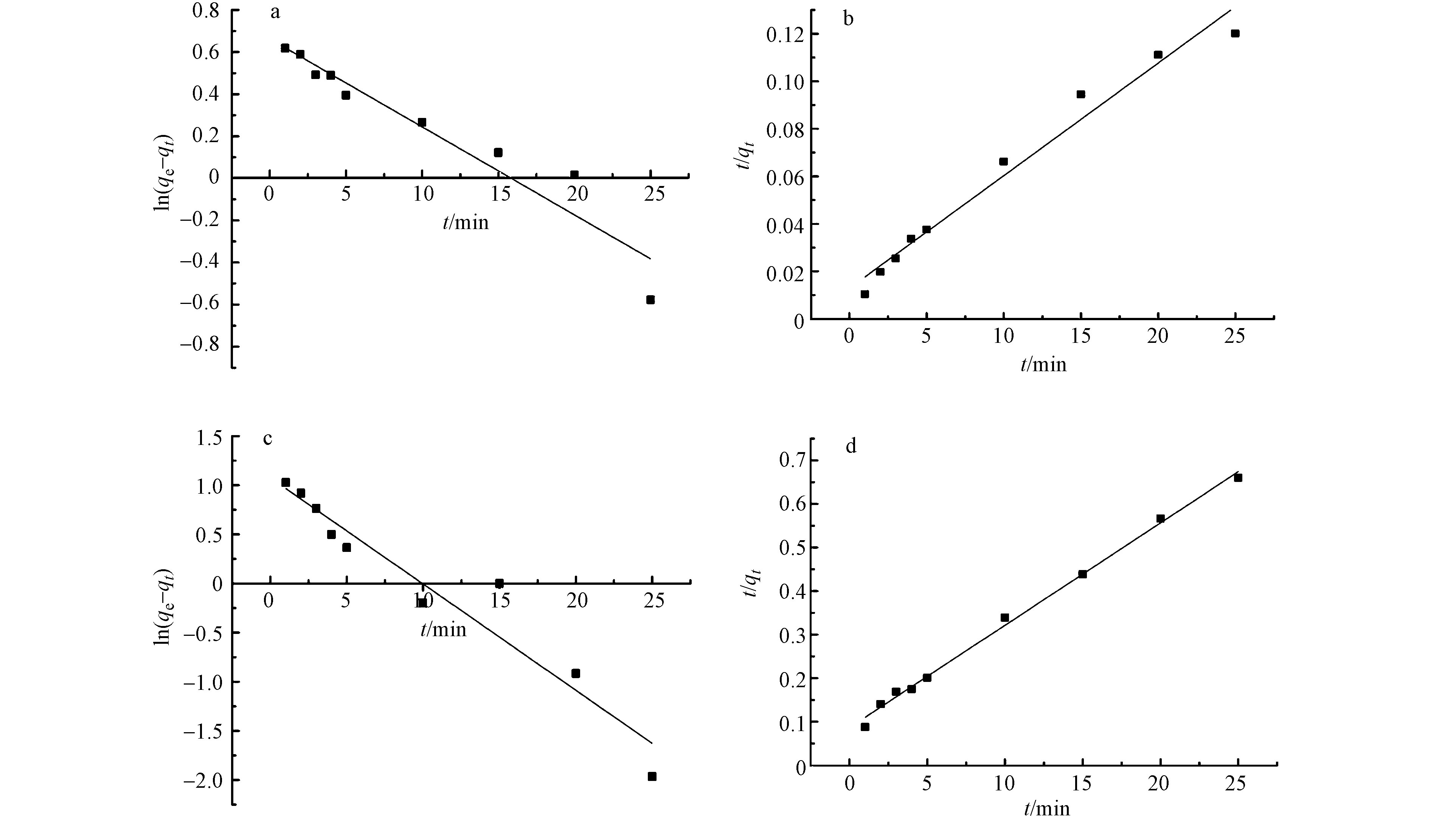 图 12 吸附动力学曲线拟合(a)伪一级动力学方程(nZVI对Cd(Ⅱ)),(b)伪二级动力学方程(nZVI对Cd(Ⅱ)),(c)伪一级动力学方程(EG-nZVI对Cd(Ⅱ)),(d)伪二级动力学方程(EG-nZVI对Cd(Ⅱ))Figure 12. Adsorption kinetics fitting: (a)pseudo-first-order(nZVI on Cd(Ⅱ)), (b)pseudo-second-order(nZVI on Cd(Ⅱ)),(c)pseudo-first-order(EG-nZVI on Cd(Ⅱ)) and (d)pseudo-second-order(EG-nZVI on Cd(Ⅱ))表 3 不同样品去除Cd(Ⅱ)的动力学参数Table 3. Constants for the kinetics for the removal of Cd(Ⅱ) on different specimens
图 12 吸附动力学曲线拟合(a)伪一级动力学方程(nZVI对Cd(Ⅱ)),(b)伪二级动力学方程(nZVI对Cd(Ⅱ)),(c)伪一级动力学方程(EG-nZVI对Cd(Ⅱ)),(d)伪二级动力学方程(EG-nZVI对Cd(Ⅱ))Figure 12. Adsorption kinetics fitting: (a)pseudo-first-order(nZVI on Cd(Ⅱ)), (b)pseudo-second-order(nZVI on Cd(Ⅱ)),(c)pseudo-first-order(EG-nZVI on Cd(Ⅱ)) and (d)pseudo-second-order(EG-nZVI on Cd(Ⅱ))表 3 不同样品去除Cd(Ⅱ)的动力学参数Table 3. Constants for the kinetics for the removal of Cd(Ⅱ) on different specimens样品Specimen 实际平衡吸附量qexq/(mg·g-1) 伪一级动力学模型Pseudo-first-orde kinetics model 伪二级动力学模型Pseudo-second-order kinetics model 伪一级方程吸附速率常数 k1/(min-1) 平衡吸附量qeq/(mg·g-1) 相关系数R2 伪二级方程吸附速率常数 k2/(mg mg-1 min-1) 平衡吸附量qeq/(mg·g-1) 相关系数R2 nZVI 142.4 0.0451 133.64 0.9135 0.174 139.16 0.9692 EG-nZVI 39.5 0.1142 31.6 0.8996 0.203 36.7 0.9956 化学吸附的成因如下:由于Fe2+/Fe标准电极电位为−0.44,而Cd2+/Cd标准电极电位为−0.40,致使nZVI内核Fe原子难以起到还原作用,nZVI与Cd(Ⅱ)之间的反应更多是nZVI表面钝化层FeOOH与Cd(Ⅱ)之间的表面电荷吸附或化学络合吸附[22]。
3. 结论(Conclusion)
(1)采用绿色合成法制备两种新型吸附剂EG-nZVI和nZVI。经FESEM和TEM表征nZVI为直径40—50 nm的球状,分散性较好,经EG负载后,纳米零价铁散布在膨胀石墨的孔隙层的表面。FTIR,EDS和XRD检测二者样品中均有铁元素的存在。BET测定显示EG-nZVI有较高的比表面积和孔体积。
(2)EG-nZVI和nZVI对含有100 mg·L −1 Cd(Ⅱ)水溶液处理的单因素优化工艺为:添加EG-nZVI 2.0 g·L −1或nZVI 0.4 g·L −1,常温下,pH 8,在超声波辅助下反应30 min,Cd(Ⅱ)去除率分别为78.4%和56.3%。在最适条件下,EG-nZVI对Cd(Ⅱ)的去除效果优于nZVI。
(3)在空气中放置不同的天数进行测定,结果显示随着放置时间的增加,EG-nZVI和nZVI对Cd(Ⅱ)去除的反应活性均下降,说明纳米零价铁在空气中被氧化,反应活性降低。放置15 d后EG-nZVI对Cd(Ⅱ)的去除效能损失(约34%)远小于nZVI对Cd(Ⅱ)的去除效能损失(约82%),说明负载EG后,对零价铁反应活性起到一定的保护作用。
(4)EG-nZVI和nZVI对Cd(Ⅱ)的去除过程拟合更符合伪二级动力学模型和Langmuir吸附等温模型。
-
图 12 吸附动力学曲线拟合(a)伪一级动力学方程(nZVI对Cd(Ⅱ)),(b)伪二级动力学方程(nZVI对Cd(Ⅱ)),(c)伪一级动力学方程(EG-nZVI对Cd(Ⅱ)),(d)伪二级动力学方程(EG-nZVI对Cd(Ⅱ))
Figure 12. Adsorption kinetics fitting: (a)pseudo-first-order(nZVI on Cd(Ⅱ)), (b)pseudo-second-order(nZVI on Cd(Ⅱ)),(c)pseudo-first-order(EG-nZVI on Cd(Ⅱ)) and (d)pseudo-second-order(EG-nZVI on Cd(Ⅱ))
表 1 不同样品的比表面积
Table 1. Specific surface area of different specimens
样品 Specimen 比表面积/(m2 ·g−1) Specific surface area 吸附累计孔体积/(cm3 ·g−1) Adsorption cumulative pore volume EG 137.5 0.227 EG-nZVI 145.9 0.221 表 2 不同温度下不同样品对水中Cd(Ⅱ)吸附等温线
Table 2. Isotherm constants of different specimens adsorption on Cd(Ⅱ) at different temperature
样品Specimen 温度Temperature/K Langmuir 方程参数Langmuir isotherm constants Freundlich 方程参数Freundlich isotherm constants Langmuir 常数KL/(mg·g−1) 理论最大平衡吸附量qm/(mg·g−1) 相关系数R2 Freundlich 常数Kf /(mg·g−1) Freundlich作用强度系数1/n 相关系数R2 nZVI 298323 0.29 200 0.9993 56.19 0.2988 0.9138 0.33 217.39 0.9991 66.109 0.2833 0.9099 EG-nZVI 298 0.31 99.01 0.9983 25.24 0.3425 0.9229 323 0.51 102.04 0.999 33.84 0.2793 0.9234 表 3 不同样品去除Cd(Ⅱ)的动力学参数
Table 3. Constants for the kinetics for the removal of Cd(Ⅱ) on different specimens
样品Specimen 实际平衡吸附量qexq/(mg·g-1) 伪一级动力学模型Pseudo-first-orde kinetics model 伪二级动力学模型Pseudo-second-order kinetics model 伪一级方程吸附速率常数 k1/(min-1) 平衡吸附量qeq/(mg·g-1) 相关系数R2 伪二级方程吸附速率常数 k2/(mg mg-1 min-1) 平衡吸附量qeq/(mg·g-1) 相关系数R2 nZVI 142.4 0.0451 133.64 0.9135 0.174 139.16 0.9692 EG-nZVI 39.5 0.1142 31.6 0.8996 0.203 36.7 0.9956 -
[1] SHARMA I, SHARMA S K, SAMBI S S. Cadmium and chromium adsorption on activated carbon [J]. Indian Chemical Engineer, 2014, 56(2): 97-105. doi: 10.1080/00194506.2014.903624 [2] FU R B, YANG Y P, XU Z, et al. The removal of chromium (Ⅵ) and lead (Ⅱ) from groundwater using sepiolite-supported nanoscale zero-valent iron (S-NZVI) [J]. Chemosphere, 2015, 138: 726-734. doi: 10.1016/j.chemosphere.2015.07.051 [3] LI Y C, YUN N C, YU D S, et al. Adsorption and removal of cadmium (Ⅱ) from aqueous solutions by bio-formulation [J]. Transactions of Nonferrous Metals Society of China, 2007, 17(5): 1057-1062. doi: 10.1016/S1003-6326(07)60225-8 [4] GUO S Z, JIAO P P, DAN Z G, et al. Preparation of L-arginine modified magnetic adsorbent by one-step method for removal of Zn(Ⅱ) and Cd(Ⅱ) from aqueous solution [J]. Chemical Engineering Journal, 2017, 317: 999-1011. doi: 10.1016/j.cej.2017.02.136 [5] 魏张东. 生物炭复合肥料的制备及其对农田土壤镉污染修复效应[D]. 郑州: 河南大学, 2019 WEI Z D. Preparation of hang biocharcoal-based composite fertilizer and its remediation effect on cadmium pollution in farmland soil[D]. Zhengzhou: Henan University, 2019 (in Chinese).
[6] WANG C P, WANG B L, LIU J T, et al. Adsorption of Cd(Ⅱ) from acidic aqueous solutions by tourmaline as a novel material [J]. Chinese Science Bulletin, 2012, 57: 3218-3225. doi: 10.1007/s11434-012-5341-6 [7] GAO J, YANG L Z, LIU Y Y, et al. Scavenging of Cr(Ⅵ) from aqueous solutions by sulfide-modified nanoscale zero-valent iron supported by biochar [J]. Journal of the Taiwan Institute of Chemical Engineers, 2018, 91: 449-456. doi: 10.1016/j.jtice.2018.06.033 [8] LIU J W, MWAMULIMA T, WANG Y M, et al. Removal of Pb(Ⅱ) and Cr(Ⅵ) from aqueous solutions using the fly ash-based adsorbent material-supported zero-valent iron [J]. Journal of Molecular Liquids, 2017, 243: 205-211. doi: 10.1016/j.molliq.2017.08.004 [9] XU H, YANG S H, ZHANG Y J, et al. Cr(Ⅵ) and phenol simultaneous removal using attapulgite-supported nanoscale zero-valent iron in the presence of persulfate [J]. Desalination and Water Treatment, 2020, 184: 150-162. doi: 10.5004/dwt.2020.25336 [10] ALI I, AL-OTHMAN ZA, ALWARTHAN A. Green synthesis of functionalized iron nano particles and molecular liquid phase adsorption of ametryn from water [J]. Journal of Molecular Liquids, 2016, 221: 1168-1174. doi: 10.1016/j.molliq.2016.06.089 [11] HUANG L L, WENG X L, CHEN Z L, et al. Synthesis of iron-based nanoparticles using oolong tea extract for the degradation of malachite green [J]. Spectrochimica Acta Part a-Molecular and Biomolecular Spectroscopy, 2014, 117: 801-804. doi: 10.1016/j.saa.2013.09.054 [12] MONGA Y, KUMAR P, SHARMA R K, et al. Sustainable synthesis of nanoscale zerovalent iron particles for environmental remediation [J]. Chemsuschem, 2020, 13(13): 3288-3305. doi: 10.1002/cssc.202000290 [13] ZHANG X, LIN S, CHEN Z L, et al. Kaolinite-supported nanoscale zero-valent iron for removal of Pb2+ from aqueous solution: Reactivity, characterization and mechanism [J]. Water Research, 2011, 45(11): 3481-3488. doi: 10.1016/j.watres.2011.04.010 [14] CAROLIN C F, KUMAR P S, SARAVANAN A, et al. Efficient techniques for the removal of toxic heavy metals from aquatic environment: A review [J]. Journal of Environmental Chemical Engineering, 2017, 5(3): 2782-2799. doi: 10.1016/j.jece.2017.05.029 [15] HU Z L, CAI L M, LIANG J M, et al. Green synthesis of expanded graphite/layered double hydroxides nanocomposites and their application in adsorption removal of Cr(Ⅵ) from aqueous solution [J]. Journal of Cleaner Production, 2019, 209: 1216-1227. doi: 10.1016/j.jclepro.2018.10.295 [16] JIANG L, ZHANG J, XU X L, et al. Characterization and application of expanded graphite modified with phosphoric acid and glucose for the removal of Ni(Ⅱ) from aqueous solution [J]. Applied Surface Science, 2015, 357: 2355-2363. doi: 10.1016/j.apsusc.2015.09.241 [17] ALI I, AL-OTHMAN Z A, ALWARTHAN A. Synthesis of composite iron nano adsorbent and removal of ibuprofen drug residue from water [J]. Journal of Molecular Liquids, 2016, 219: 858-864. doi: 10.1016/j.molliq.2016.04.031 [18] MOHAN K K, MANDAL B K, SIVA K K, et al. Biobased green method to synthesise palladium and iron nanoparticles using Terminalia chebula aqueous extract. [J]. Spectrochim Acta A Mol Biomol Spectrosc, 2013, 102(1): 128-133. [19] 赵云, 祝方, 任文涛. 绿色合成纳米零价铁镍去除地下水中硝酸盐的动力学研究 [J]. 环境工程, 2018, 36(7): 76-81. ZHAO Y, ZHU F, REN W T. Kinetics of nitrate removal in groundwater using green synthesized nanoscale zero valent iron-nickel [J]. Environmental Engineering, 2018, 36(7): 76-81(in Chinese).
[20] NADAGOUDA M N, CASTLE A B, MURDOCK R C, et al. In vitro biocompatibility of nanoscale zerovalent iron particles (NZVI) synthesized using tea polyphenols [J]. Green Chemistry, 2010, 12(1): 114-122. doi: 10.1039/B921203P [21] ZHAO M F, LIU P. Adsorption of methylene blue from aqueous solutions by modified expanded graphite powder [J]. Desalination, 2009, 249(1): 331-336. doi: 10.1016/j.desal.2009.01.037 [22] 孙国帅. 碳热法负载纳米零价铁对Cr(Ⅵ)和Cd(Ⅱ)的去除研究[D]. 哈尔滨: 哈尔滨工大学, 2015 SUN G S. Carbothermal synthesis of activated carbon-supported nanozero-valent iron particles for the removal of Cr(Ⅵ) and Cd(Ⅱ)[D]. Harbin: Harbin Institute of Technology, 2015 (in Chinese).
-





 下载:
下载:

